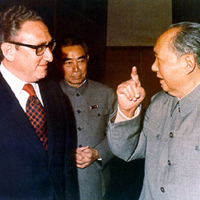Milestones
- 1969-1976: Détente
- Détente and Arms Control, 1969-1979
- The South Asia Crisis and the Founding of Bangladesh, 1971
- The First Round of Strategic Arms Limitations Talks (SALT), 1972
- Arab-Israeli War 1973
- OPEC Oil Embargo, 1973-1974
- Ending the Vietnam War, 1973-1975
- The Angola Crisis 1974-75
- Helsinki Final Act, 1975
Milestones: 1969-1976
1969-1976: Détente
The war in Vietnam continued into the presidency of Richard M. Nixon, who initially sought a resolution to the conflict in Southeast Asia by decreasing the number of troops on the ground while extending air raids into Cambodia and Laos. However, the combination of domestic anti-war fervor and Congressional determination to extend limits on Presidential war power meant that finding an end to the conflict was a political necessity.

Kissinger and Mao in China
The administration introduced the policy of “Vietnamization,” a program designed to shift the responsibility of the war from the U.S. to the South Vietnamese, allowing the United States to gradually withdraw its troops from Vietnam. Although this process was not successful, the United States negotiated a peace agreement in 1973 and withdrew from South Vietnam, which soon fell to the communist regime in the north. As the Nixon Administration worked to end the Vietnam War, National Security Adviser and Secretary of State Henry Kissinger worked toward achieving détente with the Soviet Union. Arms limitation talks with the Soviets reduced military spending and increased the sense of security, and established formal commitments to future discussions between the two powers. President Nixon and Secretary Kissinger also reached out to the other major communist power and cleared the way for future American recognition of the People's Republic of China by establishing an American policy toward Taiwan.
